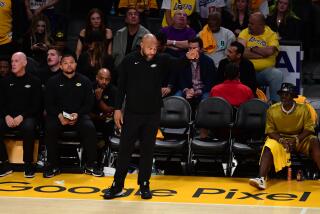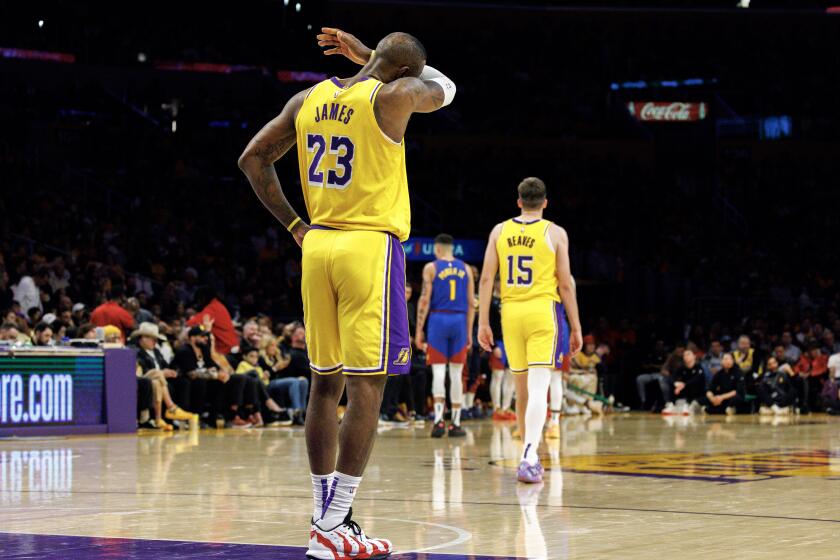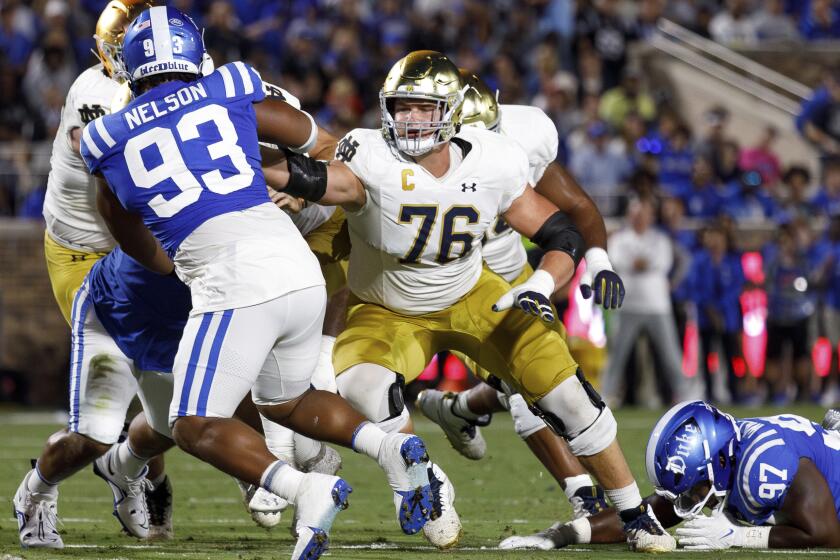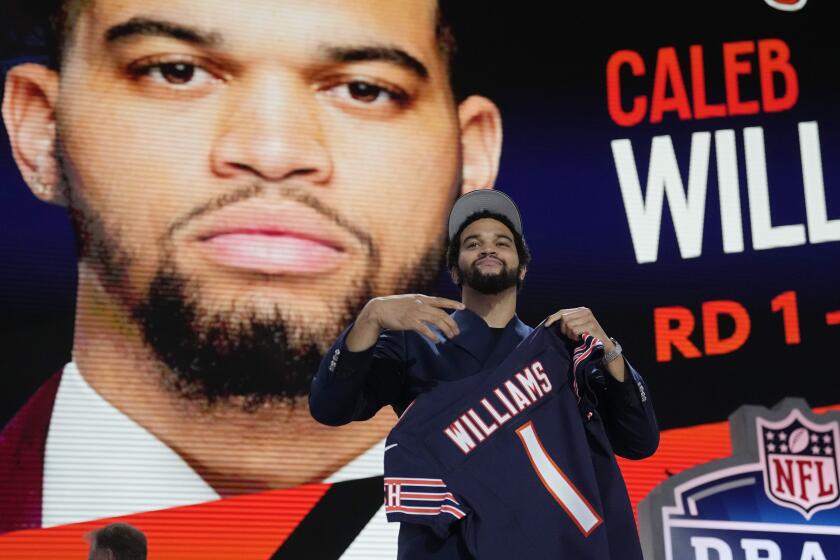HIRO AT LARGE
Hiro Matsushita sweats through a hot, oppressive afternoon at Roger Penske’s California Speedway in Fontana, testing an Indy car that is, even at 220 mph, 10 mph slower than the front-runners he will race this weekend.
He could just as easily sit behind a desk in his air-conditioned San Clemente office, acquiring more land, more money.
Matsushita owns a commercial real estate company in San Clemente and a sports-marketing agency in Japan. His grandfather founded Matsushita Electric Industrial Corp., the billion-dollar conglomerate that produces Panasonic electrical products.
As an heir to the fortune, Matsushita can do anything he wants.
So he races. But he rarely wins these days.
Matsushita is hardly on equal footing driving as part of Toyota’s engine development program with Arciero-Wells Racing. Toyota has spent the 17-race season trying to develop to match its competitors, Ford, Honda and Mercedes-Benz.
Yet, Matsushita, 36, will play an integral role in the direction of racing’s future. He also is president, chairman and owner of Swift Engineering, which produces the PPG CART World Series’ newest chassis, the Swift 007.i.
“He is one of the smartest persons I’ve ever met,” teammate Max Papis said.
He is also an invaluable driver for a developmental program, said team owner Cal Wells III.
“He has a tremendous amount of experience in all forms, he’s technically astute, computer literate and can provide quantitative feedback,” Wells said. “If you can take a pragmatic approach to racing, systematically dissect the information you get, look at it from an athletic perspective, then get the most quantitative information available, it’s extremely helpful.”
And that’s right down Matsushita’s backstretch.
His team of engineers at Swift developed the Swift chassis that Michael Andretti won with in its debut race, CART’s season opener in Homestead, Fla. It was the first American-built chassis to win an Indy car event since 1983.
Andretti’s car owner, Carl Haas, said, “In order to win races, you have to take a little risk now and then.”
Haas even agreed to be Swift’s worldwide distributor.
Swift built six chassis for four types of racing--CART, Formula Ford, Super Vee, Sports 2000--and each won in its debut. But Matsushita won’t be driving one of his chassis. Not this weekend at the Marlboro 500, maybe never.
Arciero-Wells continues using the Reynard chassis, though four Swift chassis are on order for its team in the Toyota Atlantic development series. Most Toyota Atlantic cars next season will be Swifts, and all will be in three years.
Said Wells, “In Indy car, Toyota is in the throngs of an aggressive development program. To keep variances to a minimum and provide a consistent platform, Reynard is the only chassis manufacturer that has all four engine types in its chassis. Swift is going to run Ford, and Ford only, so we couldn’t measure ourselves against Honda and Mercedes.”
But the irony of Matsushita’s situation isn’t lost on Matsushita.
“It’s strange,” he said. “I want my team to race Swift chassis, but I’m driving for Arciero-Wells as a driver. It’s the owner’s decision.
“I don’t know if it’s right or wrong. I think [the Swift and Reynard] are very much equal, but we have only two cars. If 20 cars were using the Swift, we could develop information more quickly.
“I believe the Swift chassis will be better.”
Wells said the Swift seems to be “extremely good” on short ovals and, he thinks, superspeedways.
Andretti, driving the Swift chassis, is seventh in the PPG CART World Series standings and has run as high as fourth in all but two races. And the chassis has been the least of his problems.
The team’s other driver, Christian Fittipaldi, is 15th. He crashed head-on into a wall at Surfers Paradise in Australia at 180 mph but escaped with a broken right leg and broken left foot.
Matsushita, whose highest finish this season was ninth at the U.S. 500 in Michigan, is 26th. Papis is 24th.
Matsushita’s grandfather is considered the father of Japanese electronics. Matsushita’s father is now an honorary chairman and an older brother is chairman of the conglomerate.
“I get upset when people criticize Hiro,” Papis said. “They criticize because they think, ‘Oh, he’s a rich kid, his dad is the owner of Panasonic, he can afford anything.’ But he has to prove himself too. If you’re Panasonic, you don’t just throw money [away]. Whoever wins races is not stupid. He wins because he deserves to.”
Matsushita, who came to the United States in 1986 after beginning a race career on motorcycles in 1976, has shown an ability to win. He won the 1989 championship in the Toyota Atlantic series, driving a Swift, by the largest margin in series history. Cars are prepared identically in that series, but Matsushita won four of the nine races that season.
The first Japanese driver to race Indy cars, in 1990, Matsushita was also the first to compete in the Indianapolis 500, in 1991, the year he bought Swift. He started 24th and finished 16th.
He has not been competitive lately, though, and the knock against him is that he doesn’t always get out of the way of the faster cars. “Everybody’s competing,” Matsushita said. “Sometimes, people want to complain. Some races, we cannot give them room right away.”
Andretti and Fittipaldi were the only drivers in Swift chassis this season until Richie Hearn’s car owner, John Della Penna, switched from Lola to Swift for the Fontana race.
Hearn hasn’t had much chance to test the car, but the transition should be easier than most. Haas is providing the car as a gift to Della Penna, along with three crew members who are familiar with it and the race setups. It’s the car Andretti drove to victory at Homestead.
Della Penna has run Reynards and Lolas. Now, it’s Swift’s turn.
As for Matsushita, he can only watch as other teams jump on board and make him a richer man.
More to Read
Get our high school sports newsletter
Prep Rally is devoted to the SoCal high school sports experience, bringing you scores, stories and a behind-the-scenes look at what makes prep sports so popular.
You may occasionally receive promotional content from the Los Angeles Times.






